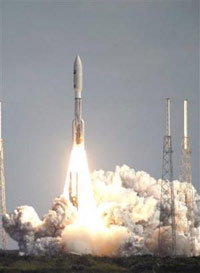|
Unmanned spacecraft hurtles toward Pluto
(AP)
Updated: 2006-01-20 07:21
An unmanned NASA spacecraft the size and shape of a concert piano hurtled
toward Pluto on Thursday on a 3-billion-mile journey to the solar system's last
unexplored planet — a voyage so long that some of the scientists who will be
celebrating its arrival are still in junior high.

An Atlas V rocket
carrying the New Horizons spacecraft on a mission to the planet Pluto
lifts off from launch pad 41 at the Cape Canaveral Air Force Station in
Cape Canaveral, Fla. on Thursday, Jan. 19, 2006.
[AP] | The New Horizons spacecraft blasted off
aboard an Atlas V rocket in a spectacular start to the US$700 million mission.
Though it is the fastest spacecraft ever launched, capable of reaching 36,000
mph, it will take 9 1/2 years to reach Pluto and the frozen, sunless reaches of
the solar system.
"God has laid out the solar system in a way that requires a certain amount of
patience on the part of those who choose to explore it," NASA administrator
Michael Griffin said.
The probe, powered by 24 pounds of plutonium, will not land on Pluto but will
photograph it, analyze its atmosphere and send data back across the solar system
to Earth.
The launch went off without incident, to the relief of anti-nuclear activists
who had feared an accident could scatter lethal radioactive material.
NASA had postponed the liftoff two days in a row because of wind gusts at the
launch pad and a power outage at the spacecraft's control center in Maryland.
"It looked beautiful," said Ralph McNutt Jr. of the Johns Hopkins University
of Applied Physics Laboratory, one of the mission's scientists. "I was getting a
little bit antsy."
Pluto is the solar system's most distant planet and the brightest body in a
zone known as the Kuiper Belt, made up of thousands of icy, rocky objects,
including tiny planets whose development was stunted for unknown reasons.
Scientists believe studying those "planetary embryos" can help them understand
how planets were formed.
Pluto is the only planet discovered by a U.S. citizen, Clyde Tombaugh in
1930, though some astronomers dispute its right to be called a planet. It is a
celestial oddball — an icy dwarf unlike the rocky planets of Mercury, Venus,
Earth and Mars and the gaseous planets of Jupiter, Saturn, Uranus and Neptune.
Tombaugh's 93-year-old widow, Patricia, was in tears as she watched the
liftoff from about four miles away, said daughter Annette Tombaugh-Sitze, who
arrived with her family from New Mexico.
"It was so awe-inspiring to watch something like this," Tombaugh-Sitze said.
"It's something you can't put into words. You just feel it."
|